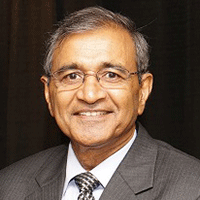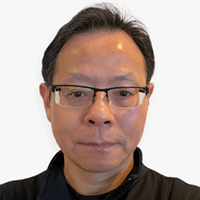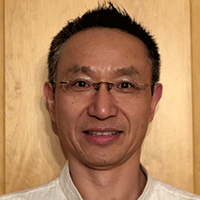
Monday, August 28, 5:00PM – 5:45PM
Bharat Bhushan
The Ohio State University (San Jose, CA)
Keynote Title: Historical Evolution of Magnetic Storage Devices and Conferences
Abstract: Telegraphic invention by Danish engineer Valdemar Poulson in 1898 was the first demonstration that a magnetic recording medium could be used to record information. It was not until 1947, that 3M shipped their first commercial oxide tape coated on paper backing, and in 1953, IBM shipped the first magnetic tape drive for data processing. IBM invented the first rigid disk drive technology called the IBM 305 Random Access Memory Accounting Machine (RAMAC). The RAMAC stored 5 MB of data and used fifty 24-inch diameter disks. The drive could be housed in a room of about 9 m x 15 m and weighed over a ton and had to be moved around by forklifts. The cost was USD $250,000 at the time (a whopping $50,000 per MB!). In 2023, one can buy a 45 TB LTO- 9 tape cartridge and 18 TB portable rigid disk drives for less than USD $150 and $300, respectively.
The magnetic recording process is accomplished by relative motion between a magnetic medium against a stationary or rotating read/write magnetic head.1, 2 For high reproduced signal amplitude, the magnetic medium needs to be in close proximity to the magnetic head. However, close proximity results in tribological issues. To minimize tribological issues, under steady operating conditions, a load carrying air film is formed. There is a physical contact between the medium and the head when starting and stopping. In modern high-end computer tape and disk drives, the surfaces are coated with ultrathin (couple of nm thick) films for corrosion and wear protection and have roughness on the order of 2 nm rms. The head-to-medium separation is on the order of 3-5 nm. Since the early 1980s, the tribology of head-medium interface has been considered a limiting technology for development of reliable and ever increasing recording densities.
Given the importance of tribology, a first ever conference on Tribology and Mechanics of Magnetic Storage Systems was held in 1984 in conjunction with ASME/STLE Tribology Conference, co- organized by Bhushan, Eiss, Bogy and Talke, and annually thereafter. Many electromechanical, materials science, design and manufacturing issues also became important. To cover an expanded scope, the first International Symposium on Advances in Information Storage Systems was organized at the ASME Winter Annual Meeting in 1990 by B. Bhushan and annually thereafter. B. Bhushan and colleagues founded an Information Storage and Processing Systems (ISPS) Sub- division in ASME in 1993 which was elevated to a Division level in 1996. In 2018, the 28th ISPS annual symposium was held and the division celebrated its silver jubilee.
The dinner keynote lecture will present historical evolution of magnetic storage devices and conferences.
1 Bhushan, B., Tribology and Mechanics of Magnetic Storage Devices, 2nd ed., Springer-Verlag, 1996.
2 Bhushan, B., Mechanics and Reliability of Flexible Magnetic Media, 2nd ed., Springer-Verlag, 2000.
3 Bhushan, B., "Micro/Nanotribology and Micro/Nanomechanics of Magnetic Storage Devices," Nanotribology and Nanomechanics – An Introduction, 4th ed., pp. 749-796, Springer, 2017.
Biography: Dr. Bharat Bhushan is an Academy Professor (San Jose, CA), and has served as an Ohio Eminent Scholar and Howard D. Winbigler Professor, and Director of Nanoprobe Laboratory for Bio- & Nanotechnology and Biomimetics at Ohio State University, Columbus, Ohio. In 2013-14, he served as ASME/AAAS Science & Technology Policy Fellow, U.S. Congress. He holds B. S., two M.S., a Ph.D. in mechanical engineering, MBA, and five honorary doctorates, a total of 10 College degrees. His research interests include Fundamental studies in the interdisciplinary areas of Bio/nanotribology/nanomechanics, Nanomaterials Characterization, Scanning Probe Techniques, Magnetic Storage, Bio/nanotechnology, Nanomanufacturing, Bioinspired Liquid Repellency, Self- cleaning, Anti-icing, Anti-fouling, and Water Harvesting, Science and Technology Policy. He has authored 10 scientific books, 100+ handbook chapters, and 900+ scientific papers. He is Google Scholar’s one of 1248 Highly Cited Researchers in All Fields, h-index - 141+ with 100 k+ citations; Scopus’s one of 401 Scientists for Career-long Citation Impact Across All Fields out of over 8 million scientists from around world; Fourth Highly Cited Researcher in Mechanical Eng.; ISI Highly Cited Researcher in Materials Science and in Cross-field Category. He has given 400+ invited presentations including 300+ keynote/plenary addresses at major international conferences on six continents. He delivered a TEDx 2019 lecture. He is the recipient of numerous awards and international fellowships and a member of International Academy of Engineering (Russia). He has previously worked for various industrial research labs including Mechanical Technology Inc., SKF, and IBM Almaden Research Center, San Jose, CA.

Monday, August 28, 12:45PM – 2:15PM
Lidu Huang
Meta
Keynote Title: Miniature Actuators and Cameras for AR and VR Applications
Biography: Lidu Huang received his Ph.D. in mechanical engineering from Rensselaer Polytechnic Institute, NY in 1997, where he focused on developing electroelastic equations to describe hysteresis in piezoelectric materials using polarization as an internal variable. Lidu gained his HDD experience at WD and HGST involved VCM optimization, inertial and magnetic latch designs, HDD dynamics and resonance frequency tuning to improve track seeking and shock performances. He also developed a novel thermal model for HAMR (Heat-Assisted Magnetic Recording) heads, which includes the back-heating effect from a stationary hot spot located approximately 1 nm directly below the NFT (Near-Field Transducer). His research further expanded to non-volatile phase change memory design. During this research, he invented a taped array structure that equalizes thermal density for all cells, resulting in a significant improvement in reliability. Lidu joined Apple in 2017, and Meta in 2020 to lead the development of miniature auto-focusing and optical image stabilization actuators for cameras. These specialized cameras are tailored specifically for wearable devices, where space and power are critical factors. Lidu has 60+ granted/pending US patents, 30+ international patents, in addition to publishing 20+ papers in engineering journals.

Tuesday, August 29, 11:00AM – 11:45AM
Dr. Huan Tang
Fremont Research Center of Seagate Technology
Keynote Title: HAMR - The Ultimate HDD Technology
Abstract: As perpendicular magnetic recording (PMR) approaches its physical limits, heat assisted magnetic recording (HAMR) is poised to take center stage and propel the hard disk drive (HDD) technology yet to new heights. In this presentation, the author will review the critical aspects of HAMR technology encompassing the head, media, and drive system. A number of the important new phenomena unique to HAMR, including the roles of the disc carbon overcoat and interface materials in the HAMR writing process and the high-temperature effects on the HAMR head disk interface and tribology, will be discussed.
Biography: Dr. Huan Tang is a Sr. Director at the Fremont Research Center of Seagate Technology, a leading data storage and solutions company in the U.S. and in the world. During a 26-year tenure at Seagate, Dr. Tang has served in many leadership roles in hard-disk drive (HDD) and recording media R&D, including technology and product roadmap architecting, technology invention, technology productization, product development, and product qualification. His research interests include head-disk interface and tribology, head-disk interaction physics during close-proximity flying and contact, disk overcoat and lubricant, disk mechanical robustness, advanced metrology, and analytical and numerical modeling. Dr. Tang has 21 issued patents in HDD technology, and has authored or co-authored over 100 papers in peer-reviewed journals in physics and tribology. He received a Ph.D. in physics from Johns Hopkins University in 1990, and was a Staff Physicist at Stanford Linear Accelerator Center prior to joining Seagate in 1997.